Intel SSD 335 (240GB) Review
by Kristian Vättö on October 29, 2012 11:30 AM ESTAnandTech Storage Bench 2011
Last year we introduced our AnandTech Storage Bench, a suite of benchmarks that took traces of real OS/application usage and played them back in a repeatable manner. Anand assembled the traces out of frustration with the majority of what we have today in terms of SSD benchmarks.
Although the AnandTech Storage Bench tests did a good job of characterizing SSD performance, they weren't stressful enough. All of the tests performed less than 10GB of reads/writes and typically involved only 4GB of writes specifically. That's not even enough exceed the spare area on most SSDs. Most canned SSD benchmarks don't even come close to writing a single gigabyte of data, but that doesn't mean that simply writing 4GB is acceptable.
Originally we kept the benchmarks short enough that they wouldn't be a burden to run (~30 minutes) but long enough that they were representative of what a power user might do with their system. Later, however, we created what we refer to as the Mother of All SSD Benchmarks (MOASB). Rather than only writing 4GB of data to the drive, this benchmark writes 106.32GB. This represents the load you'd put on a drive after nearly two weeks of constant usage. And it takes a long time to run.
1) The MOASB, officially called AnandTech Storage Bench 2011—Heavy Workload, mainly focuses on the times when your I/O activity is the highest. There is a lot of downloading and application installing that happens during the course of this test. Our thinking was that it's during application installs, file copies, downloading, and multitasking with all of this that you can really notice performance differences between drives.
2) We tried to cover as many bases as possible with the software incorporated into this test. There's a lot of photo editing in Photoshop, HTML editing in Dreamweaver, web browsing, game playing/level loading (Starcraft II and WoW are both a part of the test), as well as general use stuff (application installing, virus scanning). We included a large amount of email downloading, document creation, and editing as well. To top it all off we even use Visual Studio 2008 to build Chromium during the test.
The test has 2,168,893 read operations and 1,783,447 write operations. The IO breakdown is as follows:
| AnandTech Storage Bench 2011—Heavy Workload IO Breakdown | ||||
| IO Size | % of Total | |||
| 4KB | 28% | |||
| 16KB | 10% | |||
| 32KB | 10% | |||
| 64KB | 4% | |||
Only 42% of all operations are sequential; the rest ranges from pseudo to fully random (with most falling in the pseudo-random category). Average queue depth is 4.625 IOs, with 59% of operations taking place in an IO queue of 1.
Many of you have asked for a better way to really characterize performance. Simply looking at IOPS doesn't really say much. As a result we're going to be presenting Storage Bench 2011 data in a slightly different way. We'll have performance represented as Average MB/s, with higher numbers being better. At the same time we'll be reporting how long the SSD was busy while running this test. These disk busy graphs will show you exactly how much time was shaved off by using a faster drive vs. a slower one during the course of this test. Finally, we will also break out performance into reads, writes, and combined. The reason we do this is to help balance out the fact that this test is unusually write intensive, which can often hide the benefits of a drive with good read performance.
There's also a new light workload for 2011. This is a far more reasonable, typical every day use case benchmark. It has lots of web browsing, photo editing (but with a greater focus on photo consumption), video playback, as well as some application installs and gaming. This test isn't nearly as write intensive as the MOASB but it's still multiple times more write intensive than what we were running last year.
We don't believe that these two benchmarks alone are enough to characterize the performance of a drive, but hopefully along with the rest of our tests they will help provide a better idea. The testbed for Storage Bench 2011 has changed as well. We're now using a Sandy Bridge platform with full 6Gbps support for these tests.
AnandTech Storage Bench 2011—Heavy Workload
We'll start out by looking at average data rate throughout our new heavy workload test:

The SSD 335 performs very well in our Heavy suite. It's on-par with most high-end SSDs and even manages to beat the 520 and 330. The improvement over the 330 is quite good.
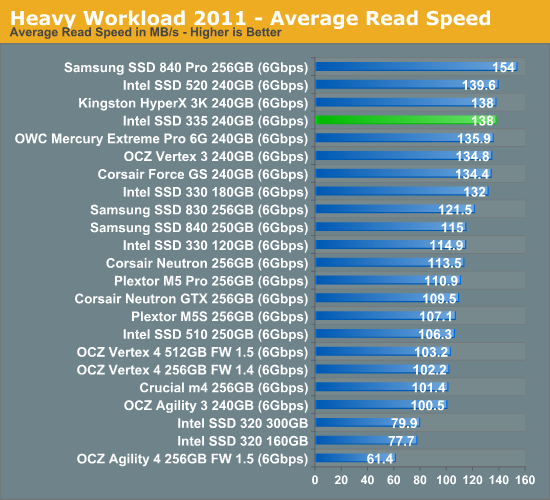
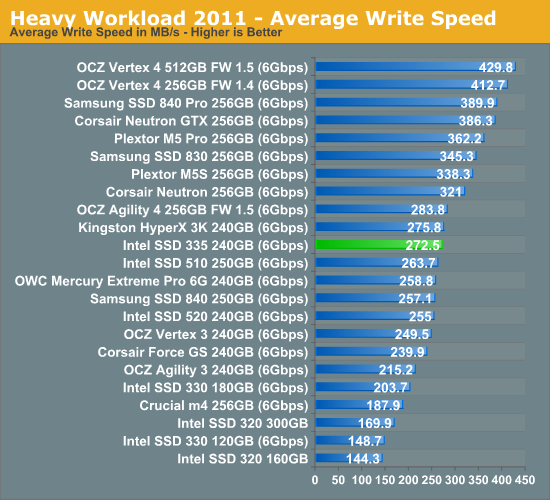
The next three charts just represent the same data, but in a different manner. Instead of looking at average data rate, we're looking at how long the disk was busy for during this entire test. Note that disk busy time excludes any and all idles, this is just how long the SSD was busy doing something:
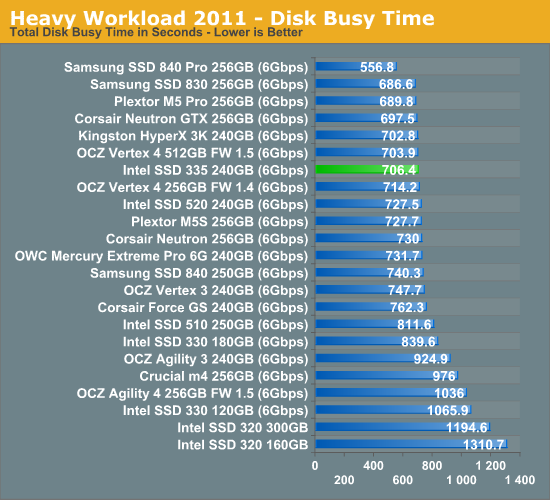
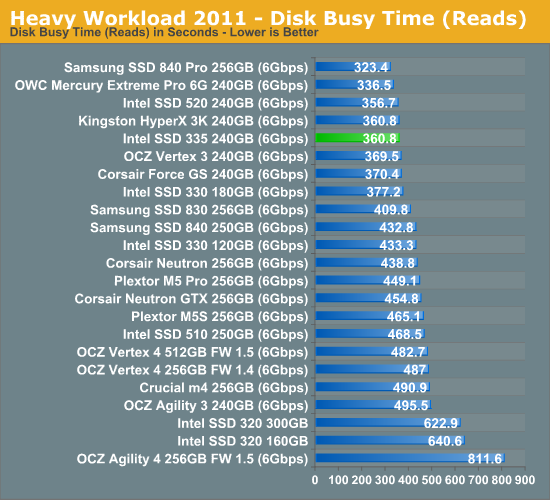
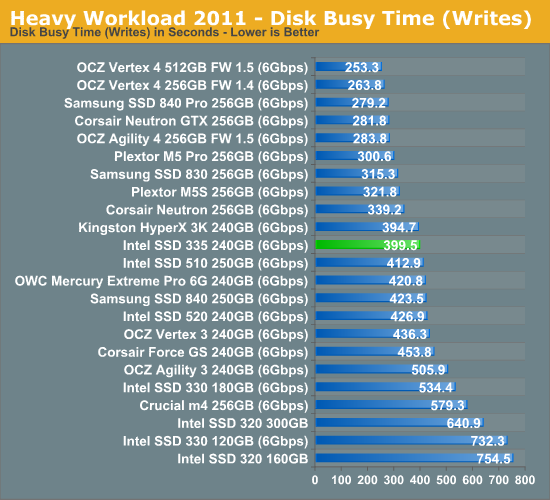










69 Comments
View All Comments
Bull Dog - Monday, October 29, 2012 - link
Do you have any hard data to back up this these assertions? Or are they just your unfounded opinions?I ask because the SSD 830 has a terrific reputation for being reliable. It has even demonstrated an exceptionally impressive lifespan over at XtremeSystems Forums.
kkwst2 - Monday, October 29, 2012 - link
Yeah, where's your data on that? I'm not aware of any data that suggests the 830 is less reliable in any way than Crucial or Intel. And my perception from experience and reviews are that Samsung has a significantly better reliability record than Sandforce. All vendors have had firmware issues to some degree, and Intel has had some pretty significant ones. The 8 MB issue on the 320 that caused data loss comes to mind.Samus - Monday, October 29, 2012 - link
Honestly the first Intel SSD I've come across dead was an SSD520 120GB, just wont detect by the system, clearly a Sandforce controller problem.I'd never seen an Intel SSD fail until now that (August 2012) and Intel has made a big mistake joining the likes of OCZ quality with its Sandforce marriage.
JonnyDough - Friday, November 23, 2012 - link
You must forget about all the issues that plague hard drives.MichaelD - Tuesday, October 30, 2012 - link
To what "Samsung drivers" are you referring? You don't need to load any drivers for this or any other SSD (at least in Windows 7, 8 and Server 2012). The driver is provided by Microsoft and has a date of 2006.And I'll note that Samsung SSDs are not plagued by the infamous "Sandforce controller bug." And that Samsung makes the controller the NAND and everything else in the SSD.
So how again, is it less reliable than other SSDs?
centosfan - Wednesday, October 31, 2012 - link
I don't think you know what you are talking about. I have two Samsung 830's and use them everyday and push they quite hard. Haven't had 1 single issue. I haven't heard of any problems with them either.hrga - Thursday, November 1, 2012 - link
It all depends about the market Samsung 830 128GB is here 170USD while 256GB version is 400USD so they aint affordable at all. While Intel 520 series 240GB costs 350USD and 120GB 180USD respectivelyseapeople - Friday, November 2, 2012 - link
So $170 and 128GB is less affordable than $180 and 120GB? You live in strange world.djshortsleeve - Monday, October 29, 2012 - link
I dont see the need for all these various models. Make a value drive and a high end one. You either buy cheapest or best.Kristian Vättö - Monday, October 29, 2012 - link
That's essentially what Intel offers. SSD 335 is the value drive, whereas the successor of SSD 520 will be the high-end one. SSD 335 and 330 are basically the same and 335 will replace the 330 sooner than later (I'm hearing Q1'13 for the other capacities).